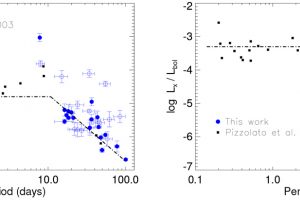Rotation and magnetic activity in M stars. The study: “HADES RV Programme with HARPS-N at TNG. X. The non-saturated regime of the stellar activity-rotation relationship for M dwarfs” of E. González-Álvarez (INAF-OAPA) recently appeared on A&A

Stellar X-ray emission arises from their corona, which is the outer part of stellar atmosphere with low-density high-temperature (up to million degrees) plasma. Even if we lack a fully understanding of the details, we know that the intensity of stellar X-ray emission depends on the intensity and the morphology of stellar magnetic field.
The interior of stars of FGK spectral types, like the Sun, is divided into a radiative and a convective region. In these stars, the magnetic field is produced by a dynamo triggered by the stellar differential rotation and the convective motion in stellar interior. The intensity of the magnetic field, and that of the observable quantities related to the magnetic field, is thus related to stellar rotation. This connection has been proven by several studies focused on FGK stars, where it is demonstrated that the X-ray luminosity (Lx) and its ratio over the bolometric luminosity (i.e.: the fractional X-ray luminosity Lx/Lbol) decrease with increasing stellar rotation period. However, this relation holds up to log(Lx/Lbol)=-3.3. For higher fractional X-ray luminosity, Lx/Lbol is saturated at an almost constant value which does not depend on stellar rotation. We still don’t know exactly what is the cause of this saturated regime.
It is important to understand whether these relations hold for smaller stars. M stars, in fact, are fully convective, and thus their magnetic fields are produced with a different dynamo with respect FGK stars. The analysis of the connection between X-ray luminosity and rotation period in these stars can shade some light on their dynamo mechanism. This is the objective of the study “HADES RV Programme with HARPS-N at TNG. X. The non-saturated regime of the stellar activity-rotation relationship for M dwarfs” of E. González-Álvarez (INAF – Astronomical Observatory of Palermo, now at the Centro de Astrobiologia of Madrid), recently appeared on Astronomy & Astrophysics. From the rotation periods of 78 stars with temperature ranging between 3400 and 3900 K, obtained from series of spectroscopic observations acquired in the framework of the HArps-N red Dwarf Exoplanet Survey (HADES) project, and their X-ray luminosity obtained from archival observations with XMM-Netwon and ROSAT satellites, the authors of this study have analyzed how in these stars Lx/Lbol varies with the rotation period. They have found that the decline of the fractional X-ray luminosity with rotation period observed in FGK stars holds at low mass regime, despite their different internal structure and dynamo. The authors of this study have also estimated that M stars typically are in the “saturated” regime for their first 300 million years of evolution. The astronomers , , , e S. Benatti, of INAF – Astronomical Observatory of Palermo, are part of the authors of this study.
The figure (link) shows Lx and Lx/Lbol over the rotation period for all the stars studied in this work and the M stars analyzed by Pizzolato et al. 2003, with the “saturated” and “not saturated” regimes clearly evident.
by Mario Giuseppe Guarcello ( follow mguarce)
